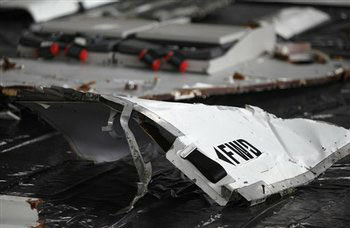
|  |  |  Americas & Beyond | June 2009 Americas & Beyond | June 2009  
Air France Searchers Struggle in Worsening Weather
 Marco Sibaja & Bradley Brooks - Associated Press Marco Sibaja & Bradley Brooks - Associated Press
go to original
June 12, 2009


| | Debris from the missing Air France flight 447 are put on display for the media after being recovered during search operations, at Recife's Air Force base, Brazil, Friday, June 12, 2009. (AP/Roberto Candia) |  |
Recife, Brazil — Military ships and planes struggled in worsening weather Friday to find more bodies and debris from the Air France jet that likely cracked apart over the Atlantic Ocean. On the coast, investigators examined corpses and received the first wreckage: two plane seats, oxygen masks, water bottles, and several structural pieces, some no bigger than a man's hand.

Other debris from the jet – which went down May 31 with 228 people on board – will arrive by ship in Recife on Sunday and be taken to the same Air Force hangar in Recife. The most important piece recovered to date is the virtually intact vertical stabilizer, which could give the French investigative agency BEA solid clues about what prompted the crash.

"The debris will be at the disposition of the BEA and they will decide what to do with it," Brazilian Air Force Gen. Ramon Cardoso said.

So far, 44 bodies have been recovered. Cardoso said no more bodies were spotted or recovered Friday, but searchers did see more pieces of debris, slightly west of the main search area, which lies 400 miles (640 kilometers) northeast of the Fernando de Noronha islands off Brazil's northern coast.

He also said French ships equipped with sonar looking for underwater wreckage were approaching an area extending out some 70 kilometers (44 miles) from the last known position of the plane – within the main search zone.

"This is the area that is being determined to be the most probable area (where the jet entered the sea) and is where French ships are beginning to work with sonar," Cardoso said, without detailing how many French vessels were being used.

The plane's black boxes – perhaps the best hope of definitively learning what went wrong – remain elusive. A French nuclear submarine is scouring the search area in the hopes of hearing pings from the boxes' emergency beacons. The first of two U.S. locator listening devices won't arrive until Sunday.

Some of the bodies have been found more than 50 miles apart, which could support a high-altitude breakup, or simply reflect strong ocean currents in the days since the crash. Authorities hope that by identifying the victims – determining where they were sitting and examining their injuries – they will find more clues.

Meanwhile, the weather in the mid-Atlantic is bad and getting worse. Rains have reduced visibility for ships, and cloud cover has blocked satellite imagery. The seas are getting rougher, and bodies don't float indefinitely. Brazil's military will decide next week whether to halt the search for bodies on June 19 or extend it for another six days, Cardoso said.

So far, there is no evidence of an explosion or terrorist act, but a number of clues that describe systemic failures on the plane. A burst of 24 automatic messages sent during its final minutes of flight show the autopilot was not on, but it was not clear if it was switched off by the pilots or stopped working due to conflicting airspeed readings, perhaps caused by iced-over speed sensors.

Peter Goelz, former managing director of the U.S. National Transportation Safety Board, said the evidence uncovered so far suggests the Airbus A330 started breaking up in the air.

Coroners in Recife said they expected to release the first details on the condition of the corpses later Friday. Goelz and other experts said injuries such as burns or broken bones could provide important clues.

Another catastrophic plane crash at sea – the TWA Flight 800 explosion off New York's Long Island – was solved in part by laying out hundreds of pieces of recovered wreckage on a hangar floor and rebuilding the plane as best they could. That enabled investigators to pinpoint the cause – a frayed wire triggered vapor in a fuel tank – something the black boxes couldn't explain.

But that 1996 disaster happened over relatively shallow water, and nearly all the wreckage could be recovered from the sandy bottom. In comparison, relatively few pieces of Flight 447 have been recovered. Even if sonar or underwater "pinger" locators find the main wreckage, it will be much more difficult to recover from an ocean floor that drops more than a mile into mountainous crevasses.

The Brazilians have deferred all questions on the investigation to the French, who haven't said how they'll handle the wreckage.

BEA spokeswoman Martine del Bono said she "absolutely can't respond now" to questions about reconstructing the aircraft from debris. She wouldn't comment Friday on whether this is because not enough debris has been collected to make the effort worthwhile.

Without any other solid clues, investigators have focused on the possibility that external speed monitors iced over and gave false readings to the plane's computers. Air France ordered these Pitot tubes replaced on the long-range Airbus planes on April 27 after pilots noted a loss of airspeed data in a few flights on Airbus A330 and A340 models, he said.

Those incidents were "not catastrophic" and planes with the old Pitots are considered airworthy, Air France chief executive Pierre-Henri Gourgeon said.

"We will know much more, I think, after the autopsies allow us to better understand the technical causes of death, and when the debris have been examined by experts," he said.

Marco Sibaja reported this story from Recife and Bradley Brooks from Rio de Janeiro. AP writer Elaine Ganley in Paris contributed to this report. |

 |
|  |



